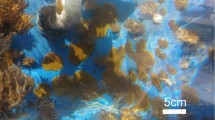Abstract
Electrophoresis was used to provide genetic evidence of the mode of production of brooded planulae in each of four species of scleractinian coral collected from the central region of the Great Barrier Reef during September, October and November 1984. Comparisons were made of the multi-locus genotypes of planulae and their broodparents for two ahermatypic (non zooxanthellate) species,Tubastraea diaphana andT. coccinea and two hermatypic (zooxanthellate) species,Acropora palifera andSeriatopora hystrix. For both ahermatypic species, all planulae were found to be genetically identical to their broodparents, including 91 planulae which were heterozygous for at least one locus. These results are consistent with asexual (ameiotic) reproduction. In contrast, non-parental genotypes were detected in the majority of hermatypic broods, which is consistent with expectations for sexual reproduction with at least some outcrossing. These data confirmed that brooded planulae may be produced both sexually and asexually and countered the suggestion that electrophoretic studies of hermatypic corals may be weakened by the contaminating effect of the enzymes of their symbiotic xooxanthellae.
Similar content being viewed by others
Literature cited
Ayre, D. J.: The effects of asexual reproduction and intergenotypic aggression on the genotypic structure of populations of the sea anemoneActinia tenebrosa. Oecologia57, 158–165 (1983)
Ayre, D. J.: The effects of environment and population density on the sea anemoneActinia tenebrosa. Aust. J. mar. Freshwat. Res.35, 735–746 (1984a)
Ayre, D. J.: The effects of sexual and asexual reproduction on geographic variation in the sea anemoneActinia tenebrosa. Oecologia62, 222–229 (1984b)
Bell, G.: The masterpiece of nature: the evolution and genetics of sexuality, 635 pp. London: Croom Helm 1982
Black, R. and M. S. Johnson: Asexual viviparity and population genetics ofActinia tenebrosa. Mar. Biol.53, 27–31 (1979)
Cutress, C. E.:Bunodeopsis medusoides Fowler andActinodiscus neglectus Fowler, two Tahitian sea anemones: redescription and biological notes. Bull. mar. Sci.29, 96–109 (1979)
Fadlallah, Y. H.: Sexual reproduction, development and larval biology in scleractinian corals. A review. Coral Reefs2, 129–150 (1983)
Harrison, P. L., R. C. Babcock, G. D. Bull, J. K. Oliver, C. C. Wallace and B. L. Willis: Mass spawning in tropical reef corals. Science, N.Y.223, 1186–1189 (1984)
Heyward, A. J. and R. C. Babcock: Self- and cross-fertilization in scleractinian corals. Mar. Biol.90, 191–195 (1986)
Highsmith, R. C.: Reproduction by fragmentation in corals. Mar. Ecol. Prog. Ser.7, 207–226 (1982)
Hyman, L. H.: The Invertebrates. Protozoa through Ctenophora, 726 pp. New York: McGraw-Hill Book Co. 1940
Resing, J. M. and D. J. Ayre: The usefulness of the tissue-grafting bioassay as an indicator of clonal identity in scleractinian corals (Great Barrier Reef-Australia). Proc. 5th int. coral Reef Congr. (In press) (1985) (Ed. by C. Gabrie et al. Moorea, French Polynesia: Antenne Museum-EPHE)
Selander, R. K., M. H. Smith, S. Y. Yang, W. E. Johnson and J. B. Gentry: Biochemical polymorphism and systematics in the genusPeromyscus. I. Variation in the old-field mouse (Peromyscus polionotus). Stud. Genet., Austin, Tex.6, 49–90 (1971). (Univ. Tex. Publ. No. 7103)
Stoddart, J. A.: Asexual production of planulae in the coralPocillopora damicornis. Mar. Biol.76, 279–284 (1983)
Stoddart, J. A.: Genetical structure within populations of the coralPocillopora damicornis. Mar. Biol.81, 19–30 (1984)
Stoddart, J. A. and R. Black: Cycles of gametogenesis and planulation in the coralPocillopora damicornis from south western Australia. Mar. Ecol. Prog. Ser. (In press) (1985)
Veron, J. E. N.: Corals of Australia and the Indo-Pacific. Sydney: Angus & Robertson (In press) 1985
Veron, J. E. N. and M. Pichon: Scleractinia of eastern Australia. I. Families Thamnasteriidae, Astrocoeniidae and Pocilloporidae. Monograph Ser. Aust. Inst. mar. Sci.1, 1–86 (1976)
Veron, J. E. N. and C. C. Wallace: Scieractinia of eastern Australia. V. Family Acroporidae. Monograph Ser. Aust. Inst. mar. Sci.6, 1–485 (1984)
Williams, G. C.: Sex and evolution, 200 pp. Princeton: Princeton University Press 1975
Willis, B. L. and D. J. Ayre: Asexual reproduction and genetic determination of growth form in the coralPavona cactus: biochemical genetic and immunogenic evidence. Oecologia65, 516–525 (1985)
Author information
Authors and Affiliations
Additional information
Communicated by G. F. Humphrey, Sydney
Contribution No. 306 of the Australian Institute of Marine Science
Rights and permissions
About this article
Cite this article
Ayre, D.J., Resing, J.M. Sexual and asexual production of planulae in reef corals. Mar. Biol. 90, 187–190 (1986). https://doi.org/10.1007/BF00569126
Accepted:
Issue Date:
DOI: https://doi.org/10.1007/BF00569126



